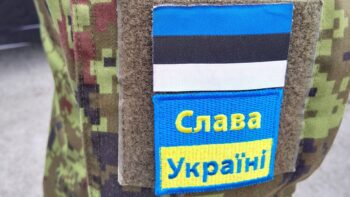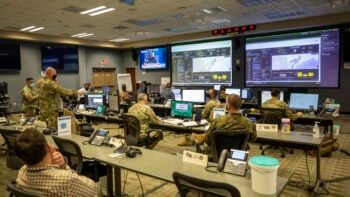
Cloud technology concept (Getty images)
AFA 2023 — Delivering cloud-based command and control (CBC2) capabilities will stay at the top of the Air Force’s priority list, even if the service falls under a continuing resolution, the official in charge of the effort said today. But, he warned, a CR could lead to the service having to pick and choose which locations it rolls the effort out to.
“The CBC2 plan that we have right now is one that we tend to preserve despite a slowdown with regards to getting budget when and where we need it,” Brig. Gen. Luke Cropsey, program executive officer for command, control, communications and battle management, told reporters at the Air, Space & Cyber conference.
“So it’s really about prioritization and how far can you get with the dollars that you have available, and if we don’t get budget by the second quarter of [fiscal year 2024], then we’re gonna have to start making other choices about other things that are in planning right now that… [we] are approved to start on that we’re going to have to basically slow roll until the money shows up,” he continued. “But CBC2, with the current fielding plan, is one that we would prioritize to the front of the list…The current fielding plan should stay intact for CBC2 if we don’t get all the money that we need up front.”
Cropsey said the Air Force plans to drop CBC2 into three different locations — which he didn’t reveal — in the “next two to three quarters” in FY24 and focus around the “air defense sectors” in the immediate term. He added that a late budget could potentially “start to impact a number of locations” where the service plans to further deploy CBC2 capabilities and its digital infrastructure currently being built out.
“You know, if we don’t get the money, and we’re going to keep what we’re doing on track, we just won’t be able to expand the actual infrastructure deployment as rapidly or to as many places as we would want to be able to get the additional dollars for going to [FY24],” he said.
The CBC2 effort is housed under the Advanced Battle Management System program, the Air Force’s contribution to the Pentagon’s Joint All Domain Command and Control initiative to connect sensors to shooters across all domains. The Air Force has awarded Science Applications International Corporation a contract for the effort.
According to a Jan. 9 Air Force press release, “CBC2 is a set of microservice applications being developed with direct warfighter feedback that leverage Platform One DevSecOps tools and Cloud One computing environments” and centralizes over 750 radar feeds into one interface.
“The system then allows operators to create machine-generated courses of action to help shorten the tactical C2 kill chain and send a desired effect via machine-to-machine connections,” according to the release.
Cropsey said as the Air Force figures out how to scale CBC2 and deploy it at US Indo-Pacific Command, European Command and other already planned locations, it will have to be tied directly back to that digital infrastructure piece — something he called “fundamentally an enabler to anything that you want to actually do from a C2 perspective.”
“So we’re gonna prioritize those things up front, and what it’ll mean is we…will have to delay how we roll in the additional scale and scope particularly on the digital infrastructure end of it, because those are where the primary cost drivers come in, as a function of time and employment,” Cropsey said. “So we’ll keep the coding going. We’ll keep that development basically at speed.”
The service is building out a digital infrastructure to accompany its new architecture to address integrated “kill chains.” The digital infrastructure aims to specifically address questions around connectivity.
“What do we need to do for compute and processing?” Cropsey said during the Air Force Life Cycle Industry Days conference in August. “How does the ability to put that capability out further toward the edge and maybe in disadvantaged locations otherwise influence and affect your ability to maintain your command and control through a variety of different operational environments?”























